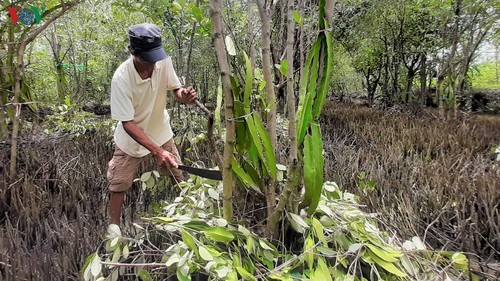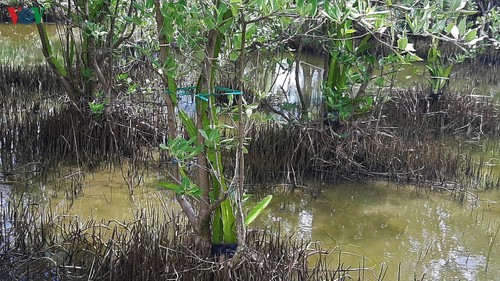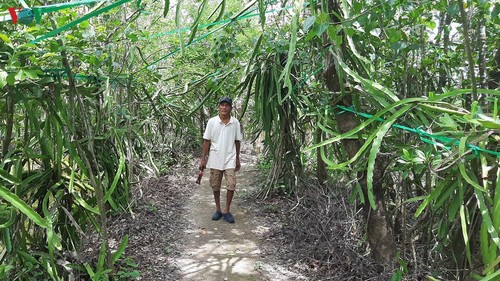 Farmer Mai Lam Phuong is initiator of the dragon fruit on avicennia tree model Farmer Mai Lam Phuong is initiator of the dragon fruit on avicennia tree model |
Lam Phuong decided to convert his family’s long unproductive shrimp aquaculture area beside a saltwater intrusion pond into fruit trees.
In 2012, Phuong began to plant a native dragon fruit variety on avicennia trees. The dragon fruit trees parasitize and take nutrients directly from the avicennia trees. Although the model was initially considered strange and unlikely to be successful, Phuong was determined to pursue it.
He recalled, “I had tried the dragon fruit varieties of Binh Thuan and Tien Giang but they all died. I decided to use the native trees after seeing that they survived even in saltwater. At first I didn’t have enough money to build support pillars for the trees to lean on, so I hung them on other trees growing on the banks of the pond. Since then, any trees which survive continue to be used.”
After two years, Phuong had hung 400 dragon fruit trees on mangroves and avicennias which, to the surprise of many locals, produced big, round, beautiful fruits.
He used other trees typical of the local mangrove ecosystem as pillars for his dragon fruit trees, but all of them eventually died - except the avicennia trees. The dragon fruit trees clinging to avicennia trunks have grown steadily and the avicennias themselves have remained strong. The fruit grove gives Phuong’s family a profit of hundreds of dollars a year.
 Dragon fruit trees parasitize and take nutrients from avicennia trees. Dragon fruit trees parasitize and take nutrients from avicennia trees. |
Phuong recalled, “At first I thought dragon fruit grown on saltwater would taste salty and be pretty acrid. Unexpectedly the fruit is sweet, delicious, and looks even more beautiful than dragon fruit grown by traditional methods. At first I sold the fruit for 22 cents a kilo. As market demand has grown, I have doubled the price. Growing dragon fruit on avicennia trees generates a good profit.”
While waiting for the avicennia trees beside the former shrimp pond to grow big enough, Phuong experimented with dragon fruit saplings in small pots and later hung them on the avicennias beside the pond. The fruit trees develop normally even in salt water.
Despite saltwater intrusion Phuong now has more than 1,000 dragon fruit trees on one hectare of what used to be an aquaculture area.
 Phuong now has more than 1,000 dragon fruit growing on avicennia trees. Phuong now has more than 1,000 dragon fruit growing on avicennia trees. |
Ly Thi Lan, Deputy Chairwoman of the district’s Farmers Association, said, “For a long time, local people paid little attention to the local variety of dragon fruit. Since Phuong revived it, the quality and appearance of the fruit has much improved. Characteristically, 70% of dragon fruit develop aerial roots attached to the trunks of other trees. When they parasitize avicennia trees, they often grow very well.”
Phuong’s model has been applauded and encouraged to expand in Ca Mau to improve the local environment and help other farmers boost their incomes.